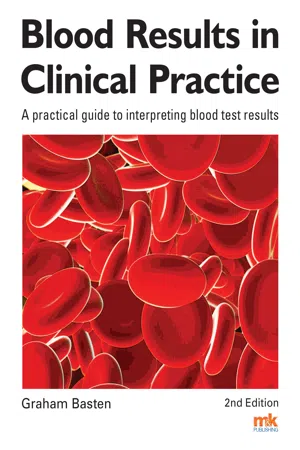
Blood Results in Clinical Practice: A practical guide to interpreting blood test results
2nd Edition
- English
- ePUB (mobile friendly)
- Available on iOS & Android
Blood Results in Clinical Practice: A practical guide to interpreting blood test results
2nd Edition
About this book
This book was originally written after feedback suggested that storytelling was very helpful to students and practitioners wanting to remember blood tests and their implications. Each section, where appropriate, therefore contains a 'story', as well as an overview of the relevant anatomy, physiology and biochemistry. This revised, updated edition continues to use storytelling to aid understanding, and introduces a unique 10-point system to help explain blood results. The use of storytelling has also been significantly improved and refined, following several years of feedback on the first edition. Less formal than a biochemistry textbook and containing more narrative than an online protocol, Blood Results in Clinical Practice provides an excellent, accessible introduction to blood tests and what they mean. It also enables advanced practitioners to reflect on and improve their practice; and includes new and updated sections of relevance to physiotherapists, paramedics, pharmacists and advanced nurse practitioners. Finally, it provides a resource for patients and their relatives who may be keen to know more about the meaning and function of particular blood tests.
Frequently asked questions
- Essential is ideal for learners and professionals who enjoy exploring a wide range of subjects. Access the Essential Library with 800,000+ trusted titles and best-sellers across business, personal growth, and the humanities. Includes unlimited reading time and Standard Read Aloud voice.
- Complete: Perfect for advanced learners and researchers needing full, unrestricted access. Unlock 1.4M+ books across hundreds of subjects, including academic and specialized titles. The Complete Plan also includes advanced features like Premium Read Aloud and Research Assistant.
Please note we cannot support devices running on iOS 13 and Android 7 or earlier. Learn more about using the app.
Information
1
Blood results made easy
‘Storytelling’
Key themes
What are we measuring?
Why did we measure it?
When did we measure it?
What do we do next with the result?
Question 1 – How far out of range is it?
Question 2 – Does the result make sense?
Question 3 – What do the family groups tell us? Do they all agree?
Question 4 – Is this an important blood test?
Reading the result
Table of contents
- Cover Page
- Title Page
- Copyright
- Contents
- Preface
- Abbreviations in the text
- 1 Blood results made easy
- 2 What are we actually measuring and why does this matter?
- 3 Family groups
- 4 Case study: Interpreting abnormal results
- 5 The full blood count
- 6 Coagulation and deep vein thrombosis
- 7 Inflammatory markers
- 8 The immune system
- 9 Transfusion testing
- 10 Chronic disease markers: Diabetes
- 11 Chronic disease markers: Cholesterol
- 12 Chronic disease markers: Chronic obstructive pulmonary disease and acid base
- 13 Thyroid function
- 14 Bone profile
- 15 Renal function: Urea and electrolytes
- 16 Liver function tests
- Afterword
- Further reading and references
- Index